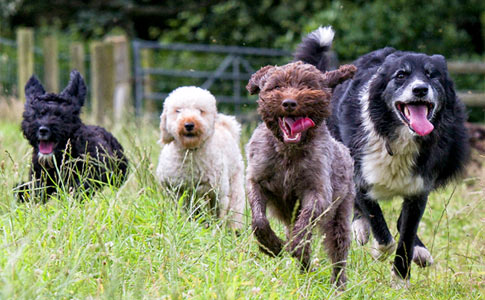
By Boni
A guest writer for the DogsBite.org Blog.
I’m sure dear readers you thought I was going to say {insert vicious pit bull joke, here}. Nope, not today.
What we’re going to try and figure out, is what can pit bulls do, that another dog cannot do better?
Pit bulls, since their inception, have been bred to fight. A pit bull that doesn’t fight, is a failed pit bull. Now, before all our pit bull aficionado friends get their Black Sabbath or White Claw t-shirts in a wad, let me clarify. If you purchase a golden retriever and it has zero natural drive to chase a ball or a find a duck—it’s a failed retriever. It might be a friendly dog, it might be an excellent pet but it comes from a subpar line of retrievers and is unsuited to purpose. If you purchase a Jack Russell that has zero interest in chasing small rodents and doesn’t have the daily energy supply of a poodle after four espressos, it’s a failed Jack Russell. It doesn’t take a rocket surgeon to realize that such a game little dog has a deserved reputation as an ankle-biter and while not all JRTs do this, JRT fanciers won’t hop on Facebook screaming “doggy racism” when a skateboarder claims to have shredded ankles from the local neighbourhood’s dreaded terrier-ist. The tiny menace might be a crap housepet but it’s a great Terrier.
A failed line of dogs can make perfectly fine family dogs. Having lower instinctual drive makes for better companion dogs in most cases particularly when the drive is tamped down and more sociability bred in. The problem asserts itself when a dog from that line of companionable dogs exhibits its natural instincts with an owner who is completely unprepared to deal with it. A setter who wants to hunt, while annoying to the average family, isn’t likely to be dangerous on the loose no matter how many fences it climbs in search of squirrels to point at. Last I checked, no babies or seniors have ever been pointed to death.
Pit bulls are good at a few things other than fighting. One is weight-pull. While the world champions are Malamutes for obvious generational breeding reasons, pound-for-pound pit bulls can pull a lot of weight. Many, over two thousand pounds of weight, wheels on pavement. Yes, you read that right—two thousand pounds in pit bulls under 50lbs. (https://breedingbusiness.com/weight-pulling-dogs/) So, that 90lb woman with a pit bull on a harness and lead being jerked along thinks she has control over that 50lb pit bull? Absolutely not. Any physically capable dog over 50lbs can pull a 200lb person off their feet in six feet of torque on a harness. Easily. That’s simple physics. A pit bull at 1/10th of the strength of a trained pulling dog is still a pantload of hauling power even if they’re not trained to pull. Same with sled dog breeds. Dog trainers know this. They don’t muscle a large dog into heeling with a harness—they outsmart it with the understanding of physics, psychology and operant conditioning.
Dogs per pound are far stronger and more agile than humans. If they had opposable thumbs and a more advanced cortex, they’d be keeping us as pets.
Where does this lead us, pardon le pun, good readers?
We have a pit bull dog with an innate drive to treat other dogs as prey that excels at pulling tremendous weight. Meaning, we shouldn’t be surprised about pit bulls mauling other animals as prey and/or the people (including their owners) trying to block them from their prey, or the results of death or dreadful injury. We need to comprehend how many of them could be doing it but due to the fact that so many are failed pit bulls—it’s lucky that the attack statistics are as low as they are. While there are no definitive government statistics what the pit bull population in the USA, is—I think we can hazard a guess and say “far more than there will ever be facilities, for” just from the amount that land in shelters/pounds/rescues where the numbers vary from 20-50% of the cage space, roughly. While not the most popular family dog—they are likely the highest percentage of molaser dogs readily available to the public due to their cheap cost and over-representation in rescues/shelters/pounds.
What else are pit bulls good at?
Well, before we go there, let’s look at dog sports in general and what that means in terms of how companionable or serviceable a pit bull might be. To look at dog sports we need to look at a few factors. One is, “what is a natural fit” for a certain breed of dog or dog mixed with those breeds and two is, “How biddable does a dog need to be to compete in that sport at a high level of complexity?” and three is, “How much distraction is there, while the dog is performing its assigned tasks?” Then we can look at why pit bulls are often not useful for most dog sports or when they are capable, why they are often not top-notch candidates and what we might conclude from those observations.
One of the reasons certain breeds are not good at particular dog sports can be physical disadvantages and breeding traits. Let’s take dock diving. This is one of the most fun dog sports to watch for the average person. There’s no natural instinct for a dog to dive off a dock. Rottweilers aren’t good at dock diving not because they lack the drive to jump at or secure the target toy on command but simply because they are too chest heavy to leap 20+ feet off a dock and are poor swimmers. That’s can be a problem for many pit bulls as well. English bulldogs can outright drown without life-jackets. Huskies are agile enough for water sports but their natural Northern instincts makes them leery of being wet for long. Even when they are willing to swim their wet heavy coat slows them down making them poor contenders. Corgis, in life-jackets, dock diving. Cuteness level 1000. Winning potential, zero. TikTok celebrity status? Instant.
This doesn’t mean that all sorts of weird combinations of dog and sport don’t happen just for fun. They do. There’s always going to be someone with a stubby non-conformist energetic basset hound that’s just got to try agility and they have a blast at it. There are plenty of people who put sob story rescue dogs into all sorts of competitions for fun that never win anything but the audience’s hearts. I saw an owner win a round in an international talent contest while one of her dogs peed all over the stage right after the audience boo-hooed over her power point presentation about rescuing dogs that were destined to be butchered for food. Now there’s a failed training methodology with a winning sob story.
As long as the dog doesn’t munch the other dogs, the owner, the judge or the audience and holds its bodily contents during the trial—there’s nothing wrong with just competing for the fun of it with a dog eager to try. That, however says nothing about the general character of which types of dogs give commendable performances in which sports and what that says about the breed.
Let’s go through some dog sports together, shall we?
Herding. This includes sheepdog trials, herding and Treibball where a dog herds large balls on cue. Plenty of dogs don’t herd, they aren’t bred for it so they lock into prey drive and attack their targets or stand around baffled or barking. As proper herding trials take place outdoors, in some areas there can be high distractability from smelly grass, squirrels, birds etc. So, in fairness to pit bulls, let’s throw out all non-herding breeds with zero expectation on the actual herding trials and keep the game of Triebball.
There’s no reason a Westie or a pit bull can’t compete in Triebball and in fact, some pretty strange choices have competed although they don’t tend to win. Triebball is an event where dogs shove balls to a goal area on command. There’s video of a standard poodle I found hilarious because the poodle figured out how to shove the balls through the back of the penning area by careening the ball off the back wall and having discovered this, being a clever poodle and not a herding dog—proceeds to shove the next few balls through the back regardless of the handler frantically waving instructions. Triebball requires superior off-lead skills as well as strong biddability and attention span for details with a high tolerance for frustration while learning. Best Friends Animals Society claims to teach pit bulls Triebball as a training exercise (https://bestfriends.org/stories-blog-videos/latest-news/having-ball-treibball-dogs—note the dog in the photo is not offlead which is a must for Triebball) but there’s no video provided I found proving that her rescue pit bulls do so with any measurable success. This is a low-distraction sport with no other dogs, wildlife, prey, or numerous strange humans in the ring area.
One place where pit bulls can be top contenders is in flying disc competitions, aka frisbee catching. This is a low distraction sport without other animals around that requires short bursts of deep athletic focus. It plays into the pit bull’s strengths without triggering their drawbacks. While the most frequent winners are border collies, whippets and cattle dogs, Bootzilla the pit bull, a stunt dog, put on more than a respectable effort in this disc challenge.
Obedience and rally trial kennel club events require that the dogs be purebred by their standards unless stated otherwise. Any non-purebred cannot be titled although in some non-sanctioned matches they may win a ribbon, trophy or cash prize. This means ABPT can compete in most Kennel Club events, even some places where there is Breed Specific Legislation exceptions can be made for bully breeds provided the match provides legally compliant barriers since dogs are off-lead during some of the trials.
Yes, APBT can pass obedience trials with respectable scores to the top level of Companion Dog Excellent although it’s rare they are winners in outright competition. Obedience trials at all levels are designed for everything from a chihuahua to a Newfoundlander by adjusting the course for each size of dog. Obedience training, including for the ring, doesn’t necessarily translate into a dog that is friendly or biddable in common stressful circumstances as is borne out in numerous studies of obedience-trained dogs that bite including this one: https://www.ncbi.nlm.nih.gov/pmc/articles/PMC2610618/. That’s not just true of pit bull-types, it’s an all-too-frequent occurrence with GSDs and Rottweilers and other dogs that they show dog/human aggression outside the ring.
The more complex styles of performance training such as heelwork to music and Musical Canine Freestyle (aka “doggy dancing”) doesn’t seem to attract many pit bull owners or trainers. These exercises require long strings of commands chained together that need intense focus from both dog and handler. Most competitions do tend to be held in lower distraction environments without other dogs, present.
Included in some field and hunting trials as well as (warning: trigger alert for protection sport videos) Shutzhund, Mondioring and other protection-style trials is scent work. While this takes numerous forms, it comes down to a dog having the ability either on, or off-lead, following directions to find a scent then notifying the handler they found it, the person who smells like it or returning the item. Depending on the trial, while a pit bull may qualify, it’s hunting and retrieving dogs followed by herding breeds that do the best nosework. One or the other may excel depending on the circumstances of the specific type of trial. Pit bulls can do basic scent exercises as can brachycephalic breeds who do not scent well.
The challenge for pit bulls in protection work is two-fold. First, contrary to popular opinion it’s actually unnatural for them to latch onto a human being when they are not in drive. This holds true of many dogs. The problem for training comes in when a handler activates instinctual prey drive in a protective breed (including some rottweilers, Akitas, Kangals, etc. ) because in drive, once latched onto the trainer in the bite suit—some are too enthusiastic. That results in a struggle for the handler to compel the “out” or “return” commands.
There have been pit bulls who have passed protection type trials and handlers who like working with them but due to their less stellar performances they do not tend to be top contenders even in mixed breed trials. Also, we have to take into account that for such complex exercises, handlers have preferences of traits within a very specific breed. Winning handler/trainers are particular in the traits they desire in their demonstration dogs. Stellar public behaviour represents income. Also, as dogs learn from each other and having a lead dog to provide training assistance modelling to speed up the learning can be a valuable asset.
There are numerous pulling sports beside weight-pull such as canicross (pulling someone on skis), sledding, bikejoring (pulling a bike) and scootering. pit bulls aren’t exceptional at any of them simply because they burst with energy though often lack the stamina required. In some of the pulling sports other than weight, dogs work in teams. Pit bulls are risky in a team of dog-friendly dogs. In sledding, they lack the coat to withstand the cold. They tend to lack the calm temperament that make mastiffs, Newfoundland dogs or Bouviers good carting dogs. Carting dogs must maintain a steady task focus with tons of outside distractions such as cars, bikes, whizzing skateboards, running children, wandering cats and small yappy dogs.
There’s also flyball, with teams of dogs. This is a high distraction, energetic sport with teams of dogs barking and running past, handlers yelling encouragement to their dogs etc. It’s certainly high enough spurts of energy to burn down the excesses of a pit bull and there are videos of some pit bulls participating but I could not find teams with mixed breeds (some only allow one border collie per team, for example) that were high-level winning competitors with a pit bull on the team. If there are some, surely someone can add a video example in the comment section.
What’s our conclusion in all this? There is nothing that a pit bull can do that another dog cannot do better except fight or haul weights above their size to get to a target. Nothing.
No trainer can force a dog to be exceptional at doing something it is not naturally inclined to do. You can train a dog to perform certain tasks adequately (such as retrieving) but they will never be exceptional unless they have a natural talent for the task at hand. You can train a compliant beagle to heel with distractions but it’s first natural reaction will always be to sniff unless it’s a failed beagle. That cannot be trained out of it, just as fighting cannot be trained out of pit bulls. One day, no matter how well trained it is, when your game is off, that beagle will sniff.
Nobody can predict what day that beagle who learned to ignore distractions will sniff. Just as nobody can predict the day that that perfectly behaved pit bull will snap into drive and try to take out a poodle or its owner. The difference is that the beagle’s natural inclination won’t hurt anyone and a pit bull’s natural inclination can result in the maiming or death of another animal or, in the worst case, a human.
There are many dog sports and many enjoyable activities to participate in with a dog but there are no tasks that a pit bull excels at that cannot be enjoyed with another breed or mixed breed of dog with less risk for the average dog owner.
Consider what natural instincts you might enjoy when you are considering the dog that you will live with 24/7, for the next 15 or so, years. Many marriages don’t last that long, so choose wisely.
Attribution-NonCommercial-NoDerivs
CC BY-NC-ND June 25, 2021
Related articles:
09/30/20: Are Sensible Dog People A Dying Breed? - By Boni
03/18/16: Guest Post: Dog Trainer Shares Dog Attack Story & Professional Opinion
05/05/09: Alexandra Semyonova: Heritability of Behavior in the Abnormally Aggressive Dog








